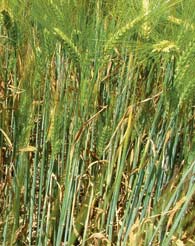Ramularia in barley moving south

Ramularia, until recently a relatively rare southern problem, can hit barley hard and fast just beyond flag leaf. The good news is that it can be controlled by a suitable fungicide strategy, says Syngenta’s Chris Rowsell.
“Its main occurrence is in Scotland and Ireland, but in recent years it has been seen in all parts of the UK.
“Because of increased reports in England, Syngenta ran a pilot study in 2008 using ELISA-based test kits to determine its incidence.”
The fungus causing the disease was first described in barley in 1893 but not named until 1988, by Sutton & Waller, as Ramularia collo-cygni due to the shape of its spores (collum= neck, cygnus = swan), notes Mr Rowsell.
The symptoms, dying spots with yellow halos on both leaf surfaces but restricted by the veins are easily confused with physiological leaf-spotting.
“In simple terms they look like short net blotch lesions, and they can increase very rapidly between flag leaf emergence and flowering.”
Physiological leaf spotting, linked to plant stress, is similar but lacks the yellow halo, is not limited by the leaf veins and is normally found only on the upper leaf surfaces, he explains.
“However both forms of spotting often occur together.”
The conditions encouraging ramularia are poorly understood though very bright days followed by dull ones seem to favour its development. “But it may just be that we’re recognising it more nowadays.”
Spring barley, more widely grown than the winter crop in the north, seems more susceptible, though that may reflect varieties grown there several years ago, he suggests.
Last season, ramularia symptoms were seen at 15 of 37 English trial sites including independent ones, says Mr Rowsell.
Tests using the German-made kit at 15 other random sites confirmed ramularia’s presence on eight. “This correlates well with the trial site incidence,” he says.
A 2008 TAG trial on Saffron winter barley where 40% of the untreated crop was affected by ramularia highlighted the value of choosing an appropriate fungicide programme.
“There was quite a high incidence of the disease there. Clearly not all of the responses were due to controlling it. There would have been other diseases present as well.
“But as part of the normal control programme, choosing a suitable fungicide strategy which will control all foliar diseases including the possibility of leaf spotting, makes good sense.
“Applying Amistar Opti at growth stage 45-49 provides an ideal combination of active ingredients. The chlorothalonil is active against ramularia and the azoxystrobin has physiological effects countering any stress which may also lead to spotting.”

